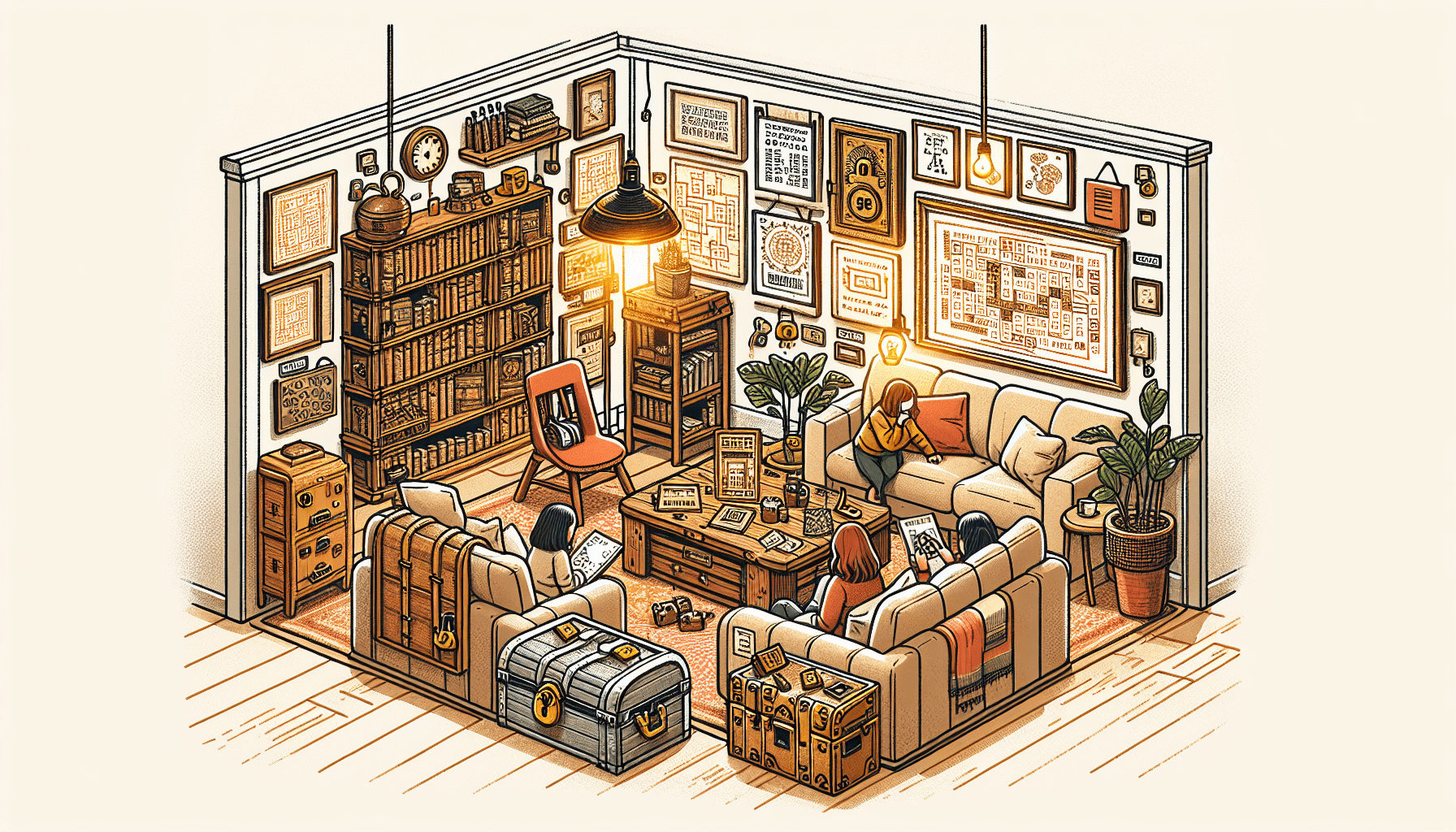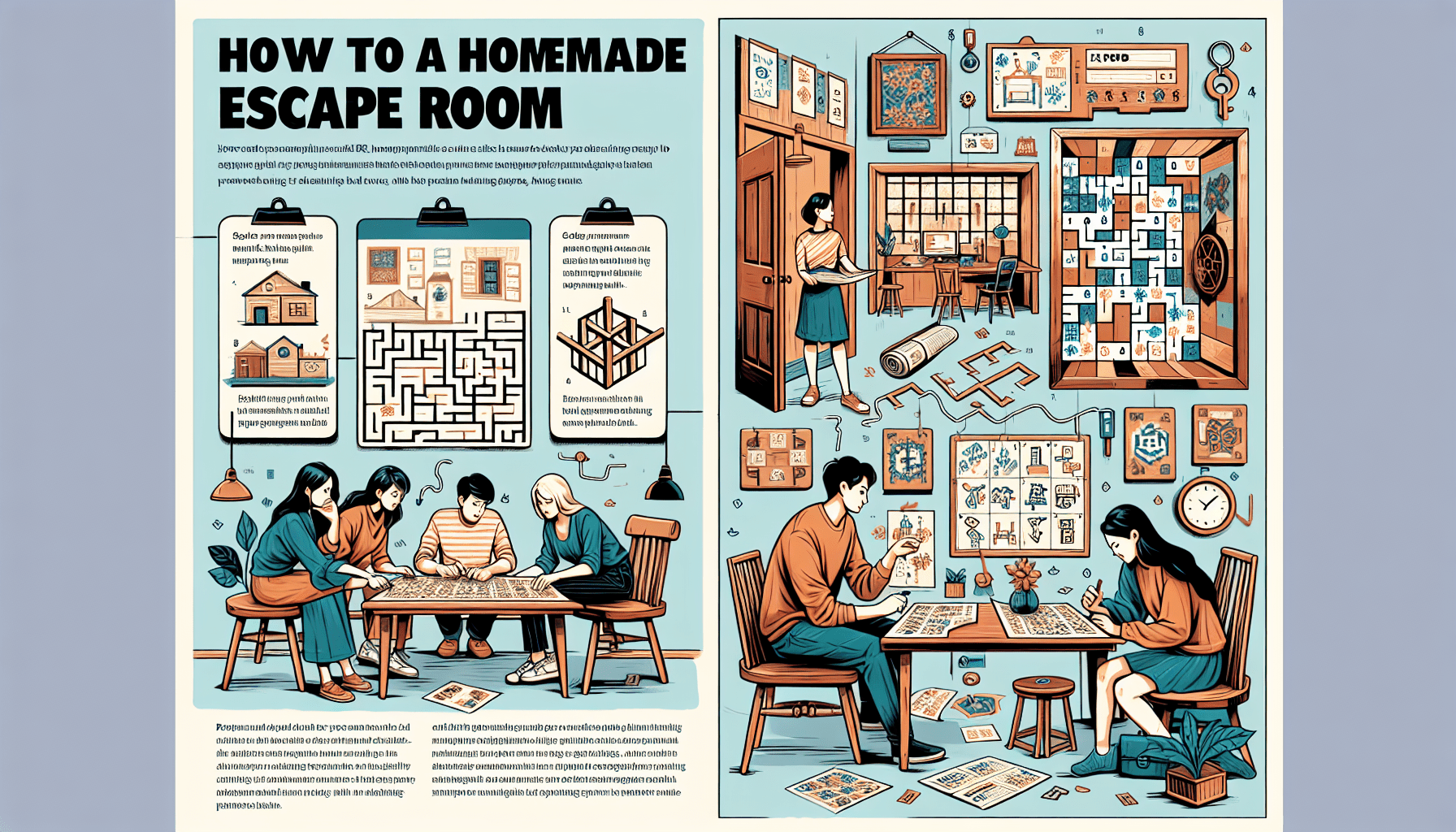Imagine the excitement of being locked in a room with your friends, racing against the clock to solve puzzles and unravel the mysteries that lie within. If you’ve ever wondered how to create your own escape room experience at home, look no further. In this article, we will explore the steps and tips you need to know to craft a thrilling homemade escape room that is bound to leave your friends begging for more. From designing captivating puzzles to creating a captivating storyline, get ready to unleash your creativity and become the ultimate master of escape.

Choose a Theme
Selecting the theme of your homemade escape room
When designing a homemade escape room, one of the first things you need to think about is the theme. The theme sets the tone and creates the ambiance that will immerse your participants into the escape room experience. It’s important to choose a theme that is captivating and engaging. Consider your interests, hobbies, or popular movie or book genres that appeal to a wide range of people. Some popular themes include haunted houses, spy missions, mystical adventures, or bank heists. By selecting a theme that piques the interest of your participants, you can ensure they have a memorable and exciting escape room experience.
Designing the Room
Creating the layout and design of the room
The layout and design of the room play a crucial role in the overall experience of your homemade escape room. Start by evaluating the space available to you and considering how you can divide it into different sections to create a sense of progression. This could include dividing the room into multiple areas like an entrance, main puzzle area, and final ‘escape’ area. Sketch out a floorplan to visualize how these areas will flow together.
Deciding on puzzles and clues
Once you have the layout and design of the room established, it’s time to think about the puzzles and clues that will challenge your participants. Consider the difficulty level you want to achieve and the age range of your players. Puzzles can include anything from codes and ciphers to riddles and hidden objects. Clues can be hidden in various objects, furniture, or other items within the room. Make sure to create a variety of puzzles to keep the participants engaged and provide different types of challenges to cater to different strengths and weaknesses.
Creating Clues and Puzzles
Deciding on the type of puzzles to include
When creating clues and puzzles for your homemade escape room, it’s important to choose a variety of types to keep the participants engaged and excited. Consider including visual puzzles, such as jigsaw puzzles or image associations, as well as logic-based puzzles, like riddles or number sequences. Additionally, think about incorporating physical puzzles that require participants to manipulate objects or use their dexterity. By offering a mix of puzzle types, you can ensure that all participants have the opportunity to contribute their strengths to solve the challenges.
Designing and crafting puzzles and clues
Designing and crafting the actual puzzles and clues is where your creativity can truly shine. Consider using everyday objects and materials to create unique and interactive puzzles. For example, you could hide clues inside books, create a lockbox using wooden blocks, or even use UV ink to create invisible messages that can only be revealed using a blacklight. Don’t be afraid to think outside the box and experiment with different materials and techniques to create truly engaging and challenging puzzles.
Setting the Atmosphere
Creating an immersive environment
To enhance the experience of your homemade escape room, it’s essential to create an immersive environment. Consider using props, lighting, and sound effects to create the desired atmosphere. If you have chosen a haunted house theme, for example, you could use dim lighting, eerie music, and spooky props to set the scene. On the other hand, if you have chosen a spy mission theme, you could utilize hidden cameras, secret passages, and high-tech gadgets to make the participants feel like real secret agents. The more you can create an immersive environment, the more captivating the escape room experience will be.
Decorating the room to match the theme
Another crucial aspect of setting the atmosphere in your homemade escape room is decorating the room to match the chosen theme. Pay attention to details and incorporate elements that are consistent with the storyline and theme. Use color schemes, posters, signage, and themed props to create an environment that feels authentic and engaging. By paying attention to these small details, you can create a fully immersive experience that transports your participants into a different world.

Setting Up Challenges
Establishing challenges and obstacles for participants to overcome
When designing your homemade escape room, it’s important to establish challenges and obstacles that participants must overcome. These challenges should be engaging, varied, and progressively more difficult as the participants advance through the room. Think about how you can incorporate teamwork, communication, problem-solving, and critical thinking into the challenges. Incorporate physical challenges like moving objects or navigating obstacles, as well as mental challenges like deciphering codes or solving complex puzzles. By designing a range of challenges, you can ensure that participants are fully engaged and have a sense of accomplishment when they overcome each obstacle.
Designing logical connections between clues and puzzles
To create a seamless and satisfying experience, it’s important to design logical connections between the clues and puzzles in your homemade escape room. Each clue and puzzle should lead the participants to the next step, creating a sense of progression and accomplishment. Make sure the clues are clear and not overly obscure, giving participants enough information to solve the puzzles without feeling frustrated. Consider creating a flowchart or a step-by-step guide to help ensure that the logical connections between clues and puzzles are well thought out and easy to follow, making the experience enjoyable for everyone involved.
Arranging Props and Objects
Collecting and organizing props and objects for the escape room
When setting up your homemade escape room, collecting and organizing props and objects is a crucial step. Start by making a list of all the props and objects you will need based on your chosen theme and puzzles. Consider repurposing everyday objects or borrowing items from friends or family to keep costs low. Once you have gathered all the necessary items, organize them in a way that makes sense within the room’s layout. This will help participants easily find and interact with the props and objects as they progress through the escape room.
Placing props strategically
The placement of props is essential in creating an engaging and challenging escape room. Think about how you can strategically place props to draw attention to important clues, create red herrings to keep participants on their toes, or enhance the overall atmosphere. Pay attention to the flow of the room and consider placing props in areas that make sense contextually within the theme and storyline. For example, if participants need to find a key to unlock a hidden compartment, you could place the key in a locked box that they must first find and solve. By placing props strategically, you can add an extra layer of intrigue and challenge to your homemade escape room.

Writing a Storyline
Developing an engaging storyline for the escape room
A compelling storyline can make all the difference in creating a memorable escape room experience. Start by brainstorming different plotlines that align with your chosen theme. Consider incorporating elements of suspense, mystery, and excitement to keep participants engaged throughout. Make sure the storyline is cohesive and drives the participants forward, providing a clear sense of purpose and motivation. Develop interesting characters and create a backstory that adds depth and authenticity to the escape room. By developing an engaging storyline, participants will feel more invested in the overall experience and enjoy the journey of solving the puzzles even more.
Integrating the storyline into puzzles and clues
Once you have developed a captivating storyline, it’s important to integrate it into the puzzles and clues of your homemade escape room. Each puzzle and clue should contribute to the overall story and help participants uncover new plot elements or advance the narrative. For example, if the storyline revolves around a stolen treasure, you could create puzzles and clues that lead participants to different pieces of the treasure map. By intertwining the puzzles and clues with the storyline, you create a more immersive and cohesive escape room experience that keeps participants engaged and eager to uncover the next twist in the plot.
Testing and Revising
Conducting test runs of the escape room
Before inviting friends or family to participate in your homemade escape room, it’s crucial to conduct test runs to ensure that everything runs smoothly and as planned. Gather a group of willing volunteers and observe how they interact with the puzzles, clues, and props. Pay attention to any areas that may be confusing or need clarification. Take notes and listen to feedback from the participants to identify areas for improvement. Testing the room with a fresh set of eyes can provide valuable insights and help you make any necessary adjustments before the official unveiling of your homemade escape room.
Making adjustments based on feedback
After conducting test runs and receiving feedback, it’s important to make necessary adjustments to improve the overall experience of your homemade escape room. Address any confusing puzzles or unclear instructions by making them more intuitive and understandable. Consider altering the placement of props or adjusting the difficulty level of certain challenges based on the feedback you received. By taking the time to make these adjustments, you can ensure that your homemade escape room is polished and provides an optimal experience for participants.

Creating a Time Limit
Setting a time limit to increase excitement and challenge
To add an extra layer of excitement and challenge to your escape room, it is recommended to set a time limit for participants to complete the room. A time limit creates a sense of urgency and heightens the adrenaline rush, making the experience more thrilling. Consider setting a reasonable time limit based on the difficulty level of your puzzles and the average completion time for escape rooms. Remember to communicate the time limit to participants before they begin and provide a visible timer within the room to help keep them aware of their progress.
Deciding on the duration for completing the room
When deciding on the duration for completing your homemade escape room, consider the complexity of the puzzles and the age and experience level of your participants. On average, escape rooms typically have a time limit of 60 minutes. However, for beginners or younger participants, you may want to extend the time limit slightly to allow for a more enjoyable experience. Conversely, for more experienced or competitive players, you could consider reducing the time limit to increase the challenge. Ultimately, the duration should strike a balance between providing an exciting challenge and allowing participants a realistic chance to complete the room within the allotted time.
Inviting Players
Inviting friends or family members to participate in the escape room
After putting in all the effort to create and fine-tune your homemade escape room, it’s time to invite friends or family members to participate. Consider who would enjoy the challenge and adventure of an escape room and extend a warm invitation to them. Let them know the date and time of the event and provide any necessary details or instructions they need to know beforehand. Be sure to communicate the theme, objectives, and any specific rules they need to follow. By inviting supportive and enthusiastic participants, you can enhance the overall experience and create lasting memories together.
Explaining the rules and objectives
Before beginning the escape room, it’s important to explain the rules and objectives to the participants. Clearly communicate any safety precautions, such as areas that are off-limits or items that should not be touched. Explain how the puzzles and clues are meant to be solved and any specific instructions for using props or interacting with the room. Moreover, inform participants about any additional objectives, such as finding hidden bonus clues or collecting specific items to enhance the experience. By providing clear instructions and objectives, you can ensure that everyone is on the same page and ready to embark on the thrilling escape room adventure ahead.
In conclusion, creating a homemade escape room can be a rewarding and exciting endeavor. By following these steps and guidelines, you can design a captivating and immersive experience for your participants. From selecting a theme to designing puzzles, crafting clues, and setting up challenges, each step contributes to creating an escape room that will entertain and challenge your friends and family. Remember to pay attention to the details, test your room, and make adjustments based on feedback. With careful planning and creativity, your homemade escape room is bound to be a hit and create lasting memories for all involved.
